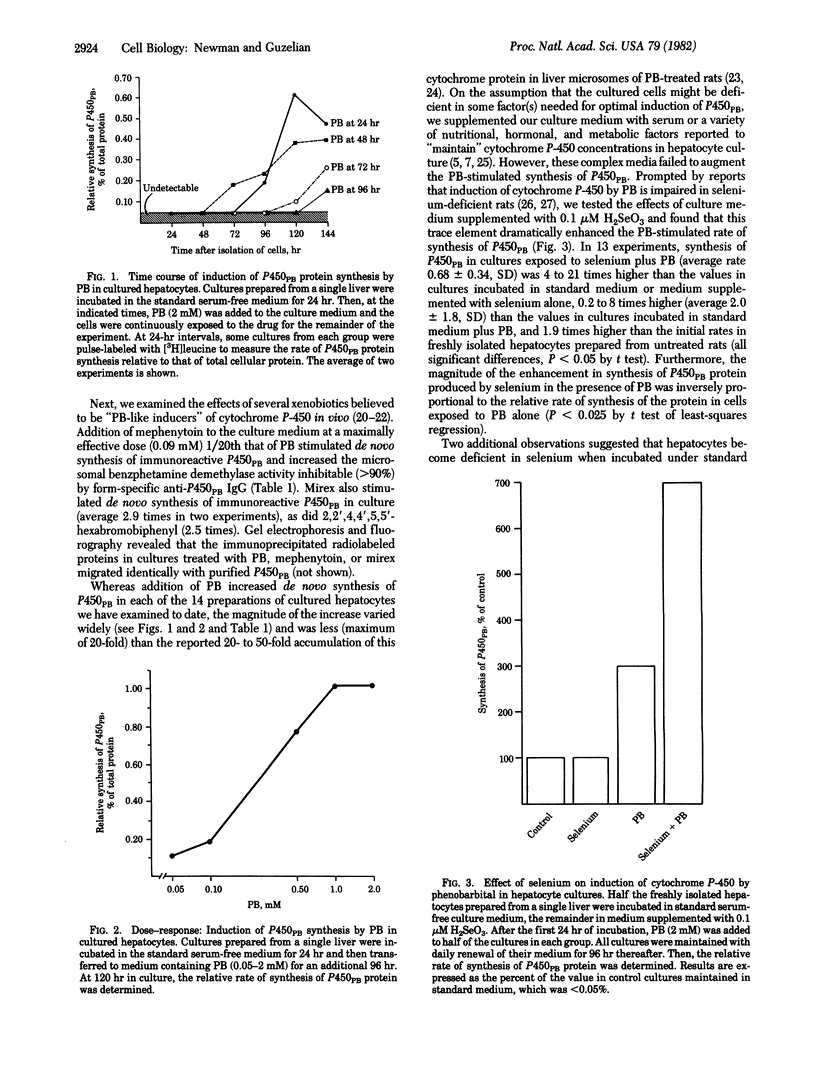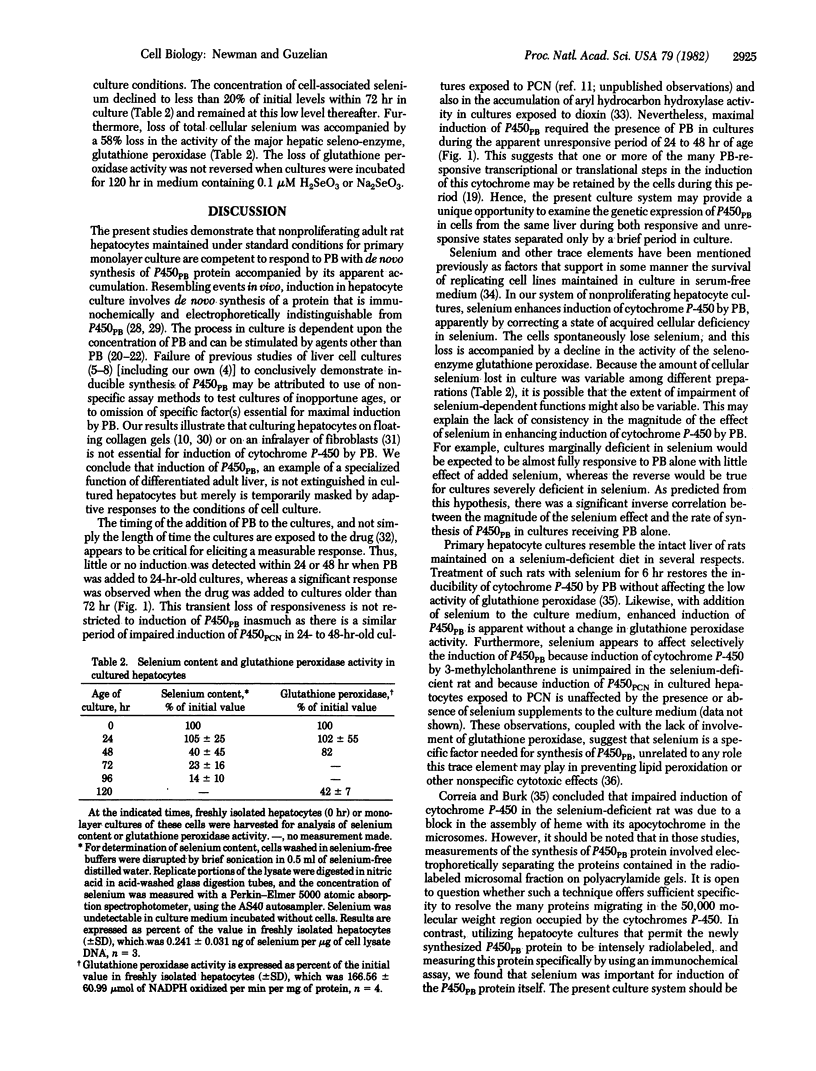Abstract
Primary monolayer cultures of nonproliferating parenchymal cells prepared from adult rat liver and maintained in serum-free medium responded to additions of phenobarbital with concentration-dependent increases in synthesis and accumulation of a cytochrome P-450 protein immunochemically and catalytically indistinguishable from that found in the livers of adult rats treated with phenobarbital. Maximal stimulation of the rate of synthesis of this cytochrome protein by phenobarbital, as much as 20-fold higher than in control cultures (1.01% of the rate of synthesis of total cellular protein), could be achieved when the drug was first added to cultures no older than 24 hr and then was maintained in the medium for 96 hr. In addition to phenobarbital, chemicals classified as "phenobarbital-like" inducers in vivo (mephenytoin, mirex, 2,2',4,4',5,5'-hexabromobiphenyl) induced synthesis in culture of this same immunoreactive protein. Supplementation of the medium with 0.1 microM H2SeO3 plus phenobarbital produced an average 2-fold enhancement in the rate of synthesis of this inducible cytochrome protein as compared to that in cultures receiving phenobarbital alone. Inasmuch as there was a decline in selenium content and in the activity of the seleno-enzyme glutathione peroxidase in hepatocyte cultures maintained in standard culture medium for more than 24 hr, the added selenium appears to correct a spontaneously acquired cellular deficiency in selenium. Contrary to the concept that liver cells placed in culture promptly dedifferentiate with general loss of specialized functions such as cytochrome P-450, our data demonstrate that expression of the phenobarbital-inducible form of cytochrome P-450 is not extinguished in culture, but rather it is masked transiently and is attenuated as the cells adapt to the imperfect conditions of the culture environment.
Full text
PDF




Selected References
These references are in PubMed. This may not be the complete list of references from this article.
- Bhat K. S., Padmanaban G. Cytochrome P-450 synthesis in vivo and in a cell-free system from rat liver. FEBS Lett. 1978 May 15;89(2):337–340. doi: 10.1016/0014-5793(78)80250-6. [DOI] [PubMed] [Google Scholar]
- Bissell D. M., Guzelian P. S. Phenotypic stability of adult rat hepatocytes in primary monolayer culture. Ann N Y Acad Sci. 1980;349:85–98. doi: 10.1111/j.1749-6632.1980.tb29518.x. [DOI] [PubMed] [Google Scholar]
- Bissell D. M. Study of hepatocyte function in cell culture. Prog Liver Dis. 1976;5:69–82. [PubMed] [Google Scholar]
- Burk R. F., Mackinnon A. M., Simon F. R. Selenium and hepatic microsomal hemoproteins. Biochem Biophys Res Commun. 1974 Jan 23;56(2):431–436. doi: 10.1016/0006-291x(74)90860-2. [DOI] [PubMed] [Google Scholar]
- Burk R. F., Masters B. S. Some effects of selenium deficiency on the hepatic microsomal cytochrome P-450 system in the rat. Arch Biochem Biophys. 1975 Sep;170(1):124–131. doi: 10.1016/0003-9861(75)90103-4. [DOI] [PubMed] [Google Scholar]
- Correia M. A., Burk R. F. Rapid stimulation of hepatic microsomal heme oxygenase in selenium-deficient rats. An effect of phenobarbital. J Biol Chem. 1978 Sep 10;253(17):6203–6210. [PubMed] [Google Scholar]
- Decad G. M., Hsieh D. P., Byard J. L. Maintenance of cytochrome P-450 and metabolism of aflatoxin B1 in primary hepatocyte cultures. Biochem Biophys Res Commun. 1977 Sep 9;78(1):279–287. doi: 10.1016/0006-291x(77)91251-7. [DOI] [PubMed] [Google Scholar]
- Elshourbagy N. A., Barwick J. L., Guzelian P. S. Induction of cytochrome P-450 by pregnenolone-16 alpha-carbonitrile in primary monolayer cultures of adult rat hepatocytes and in a cell-free translation system. J Biol Chem. 1981 Jun 25;256(12):6060–6068. [PubMed] [Google Scholar]
- Elshourbagy N. A., Guzelian P. S. Separation, purification, and characterization of a novel form of hepatic cytochrome P-450 from rats treated with pregnenolone-16 alpha-carbonitrile. J Biol Chem. 1980 Feb 25;255(4):1279–1285. [PubMed] [Google Scholar]
- Fahl W. E., Michalopoulos G., Sattler G. L., Jefcoate C. R., Pitot H. C. Characteristcs of microsomal enzyme controls in primary cultures of rat hepatocytes. Arch Biochem Biophys. 1979 Jan;192(1):61–72. doi: 10.1016/0003-9861(79)90071-7. [DOI] [PubMed] [Google Scholar]
- Fry J. R., Wiebkin P., Bridges J. W. 7-Ethoxycoumarin O-deethylase induction by phenobarbitone and 1,2-benzanthracene in primary maintenance cultures of adult rat hepatocytes. Biochem Pharmacol. 1980 Feb 15;29(4):577–581. doi: 10.1016/0006-2952(80)90379-2. [DOI] [PubMed] [Google Scholar]
- Guzelian P. S., Bissell D. M. Effect of cobalt on synthesis of heme and cytochrome P-450 in the liver. Studies of adult rat hepatocytes in primary monolayer culture and in vivo. J Biol Chem. 1976 Jul 25;251(14):4421–4427. [PubMed] [Google Scholar]
- Guzelian P. S., Bissell D. M., Meyer U. A. Drug metabolism in adult rat hepatocytes in primary monolayer culture. Gastroenterology. 1977 Jun;72(6):1232–1239. [PubMed] [Google Scholar]
- Ham R. G., McKeehan W. L. Development of improved media and culture conditions for clonal growth of normal diploid cells. In Vitro. 1978 Jan;14(1):11–22. doi: 10.1007/BF02618170. [DOI] [PubMed] [Google Scholar]
- Harada N., Omura T. Selective induction of two different molecular species of cytochrome P-450 by phenobarbital and 3-methylcholanthrene. J Biochem. 1981 Jan;89(1):237–248. doi: 10.1093/oxfordjournals.jbchem.a133187. [DOI] [PubMed] [Google Scholar]
- Hoekstra W. G. Biochemical function of selenium and its relation to vitamin E. Fed Proc. 1975 Oct;34(11):2083–2089. [PubMed] [Google Scholar]
- Kumar A., Padmanaban G. Studies on the synthesis of cytochrome P-450 and cytochrome P-448 in rat liver. J Biol Chem. 1980 Jan 25;255(2):522–525. [PubMed] [Google Scholar]
- Lawrence R. A., Burk R. F. Glutathione peroxidase activity in selenium-deficient rat liver. Biochem Biophys Res Commun. 1976 Aug 23;71(4):952–958. doi: 10.1016/0006-291x(76)90747-6. [DOI] [PubMed] [Google Scholar]
- Michalopoulos G., Russell F., Biles C. Primary cultures of hepatocytes on human fibroblasts. In Vitro. 1979 Oct;15(10):796–806. doi: 10.1007/BF02618306. [DOI] [PubMed] [Google Scholar]
- Michalopoulos G., Sattler C. A., Sattler G. L., Pitot H. C. Cytochrome P-450 induction by phenobarbital and 3-methylcholanthrene in primary cultures of hepatocytes. Science. 1976 Sep 3;193(4256):907–909. doi: 10.1126/science.948753. [DOI] [PubMed] [Google Scholar]
- Michalopoulos G., Sattler G. L., Pitot H. C. Maintenance of microsomal cytochromes b5 and P-450 in primary cultures of parenchymal liver cells on collagen membranes. Life Sci. 1976 May 15;18(10):1139–1144. doi: 10.1016/0024-3205(76)90149-1. [DOI] [PubMed] [Google Scholar]
- Moore R. W., Sleight S. D., Aust S. D. Induction of liver microsomal drug-metabolizing enzymes by 2,2',4,4',5,5'-hexabromobiphenyl. Toxicol Appl Pharmacol. 1978 May;44(2):309–321. doi: 10.1016/0041-008x(78)90193-x. [DOI] [PubMed] [Google Scholar]
- OMURA T., SATO R. THE CARBON MONOXIDE-BINDING PIGMENT OF LIVER MICROSOMES. II. SOLUBILIZATION, PURIFICATION, AND PROPERTIES. J Biol Chem. 1964 Jul;239:2379–2385. [PubMed] [Google Scholar]
- Owens I. S., Nebert D. W. Aryl hydrocarbon hydroxylase induction in mammalian liver-derived cell cultures. Stimulation of "cytochrome P1-450-associated" enzyme activity by many inducing compounds. Mol Pharmacol. 1975 Jan;11(1):94–104. [PubMed] [Google Scholar]
- Poland A., Mak I., Glover E., Boatman R. J., Ebetino F. H., Kende A. S. 1,4-Bis[2-(3,5-dichloropyridyloxy)]benzene, a potent phenobarbital-like inducer of microsomal monooxygenase activity. Mol Pharmacol. 1980 Nov;18(3):571–580. [PubMed] [Google Scholar]
- Rees D. E. The mechanism of induction of the microsomal drug hydroxylating system in rat liver by phenobarbital. Gen Pharmacol. 1979;10(5):341–350. doi: 10.1016/0306-3623(79)90068-5. [DOI] [PubMed] [Google Scholar]
- Richards G. M. Modifications of the diphenylamine reaction giving increased sensitivity and simplicity in the estimation of DNA. Anal Biochem. 1974 Feb;57(2):369–376. doi: 10.1016/0003-2697(74)90091-8. [DOI] [PubMed] [Google Scholar]
- Schacterle G. R., Pollack R. L. A simplified method for the quantitative assay of small amounts of protein in biologic material. Anal Biochem. 1973 Feb;51(2):654–655. doi: 10.1016/0003-2697(73)90523-x. [DOI] [PubMed] [Google Scholar]
- Sirica A. E., Richards W., Tsukada Y., Sattler C. A., Pitot H. C. Fetal phenotypic expression by adult rat hepatocytes on collagen gel/nylon meshes. Proc Natl Acad Sci U S A. 1979 Jan;76(1):283–287. doi: 10.1073/pnas.76.1.283. [DOI] [PMC free article] [PubMed] [Google Scholar]
- Snyder R., Remmer H. Classes of hepatic microsomal mixed function oxidase inducers. Pharmacol Ther. 1979;7(2):203–244. doi: 10.1016/0163-7258(79)90030-5. [DOI] [PubMed] [Google Scholar]
- Steward A. R., Byard J. L. Induction of benzo[a]pyrene metabolism by 2,3,7,8-tetrachlorodibenzo-p-dioxin in primary cultures of adult rat hepatocytes. Toxicol Appl Pharmacol. 1981 Jul;59(3):603–616. doi: 10.1016/0041-008x(81)90315-x. [DOI] [PubMed] [Google Scholar]
- Thomas P. E., Reik L. M., Ryan D. E., Levin W. Regulation of three forms of cytochrome P-450 and epoxide hydrolase in rat liver microsomes. Effects of age, sex, and induction. J Biol Chem. 1981 Jan 25;256(2):1044–1052. [PubMed] [Google Scholar]


